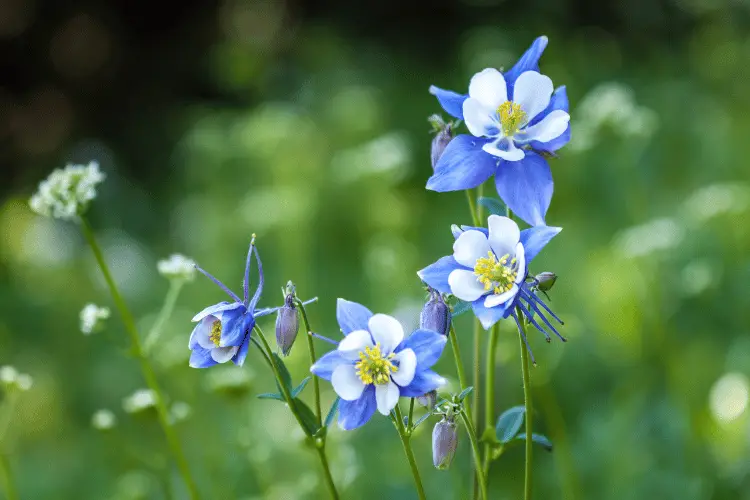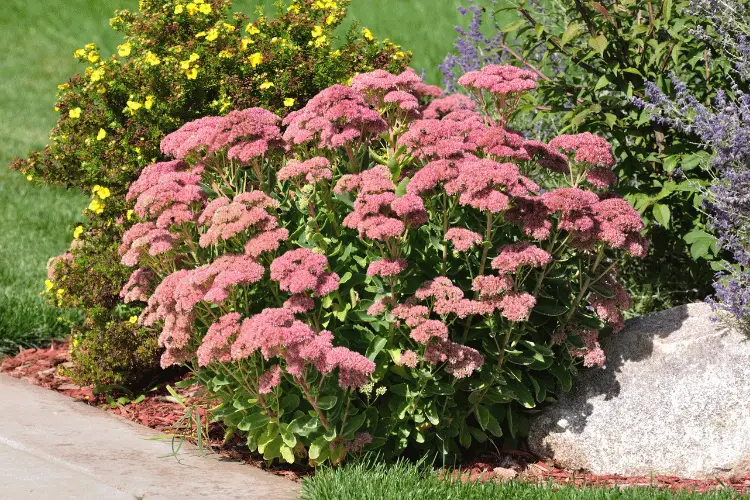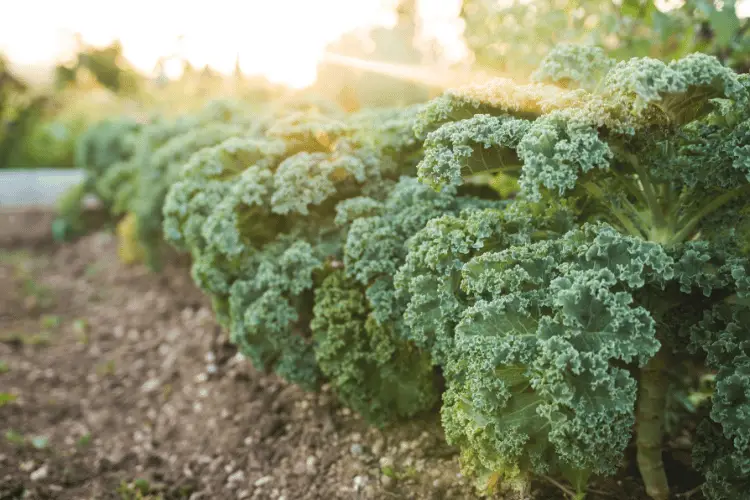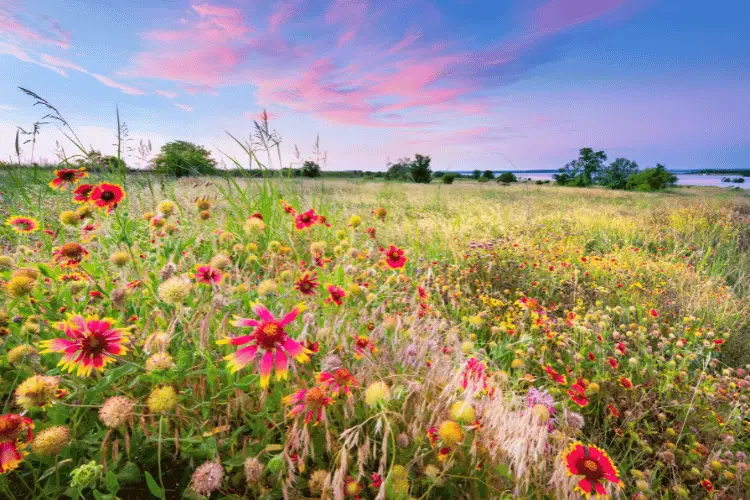We strive to provide you with authoritative, trustworthy, and expert advice. In doing so, the staff at texaswalkabout.com performs extensive research, editing, and fact checking to every post on this webiste. If you feel that this article can improve, please feel free to reach us at staff@texaswalkabout.com
Whether you’re expanding your flowerbed display or looking to harvest root vegetables, planting in Texas offers several opportunities.
Fortunately, you don’t have to be a professional horticulturist to maintain a well-balanced landscape.
That said, Texas hosts plenty of plants, from Golden Columbines to Texas Mountain Laurel. One of the challenges gardeners usually face in the Lone Star state is weather changes.
Extreme temperatures and irregular soil patterns may complicate things. The good news is that you can follow a few tips to keep your plants and flowers well-protected.
Stick around to learn more about Texas plants.
What Kind of Plants Grow Well in Texas?
Texas garners a blooming landscape for garden owners and planting enthusiasts. You can plant a variety of options, such as
Lord Baltimore Hibiscus
The Lord Baltimore Hibiscus plant will liven up your garden with its vibrant red hue. It extends over ten feet wide and can bloom from July to the winter months.
Despite dying during the frost, you’ll find them springing back up as temperatures begin to warm up. One of the most critical requirements of this crimson bloom is moist soil.
In turn, it requires periodic deep watering sessions in clay pots. The perennial thrives in low spots near ponds and streams as well.
Cape Plumbago
You’ll want to check out the Cape Plumbago shrub if you’re looking for a low-maintenance plant. The blossoms are a scenic sky blue and clustered.
The drought-resistant perennial can bloom from May to the frost season. You can plant it on a trellis and let the light blue flowers cascade down.
Caring for it involves keeping it in well-drained, sandy soil. The plant enjoys basking in the sun as well.
What Plants Are in The State of Texas?
Check out some native Texas plants below.
Texas Sage
The purple Texas Sage can grow up and spread up to six to ten feet. You can find the plant flourishing in the Chihuahuan desert, Trans-Pecos, Rio Grande, and across Edward’s plateau.
The shrub provides a pop of lavender in your garden landscape and requires minimal care. The hardy plant can withstand poor soil conditions.
The Texas Sage usually flowers after heavy rainfall. Besides that, it needs its daily eight-hour dose of Texan sunshine.
Yaupon Holly
Planting a Yaupon Holly will give your garden a lavish green backdrop to let your colorful perennials shine.
Plus, if you plant a female holly, you’ll have red berries for birds to feed off during winter. Be sure to keep these shrubs in partial or full sunlight.
When sowing it, dig a hole that’s one and a half times as large as the holly’s root ball. Prune the roots before sticking the plant in the hole.
What Grows Wild in Texas?
After going on a nature walk, you’ve likely spotted a few bright blooms. You’ve probably seen:
Texas Mountain Laurel
One of the most encapsulating features of the Texas Mountain Laurel is its enticing scent.
It’s enough to make you stop and smell the flowers. The fragrance travels far and across neighborhoods.
The plant’s green foliage is glossy and teardrop-shaped. The light purple blooms grow during the start of spring before withering after a few weeks.
These plants can grow in tree-like forms up to 10 feet wide and 15 feet tall. In the wild, they can grow an astonishing 30 to 50 feet tall.
Additionally, the Mountain Laurel natively resides in central, southern, and western Texas.
Black-Eyed Susan
The black-eyed Susan offers several benefits for its wild habitat. It gives food and shelter to bees, birds, and butterflies. The plant resembles daisies but with a sunflower color palette.
Overall, the yellow-petaled flowers enjoy full and partial sunlight. Black-eyed Susans are also perfect for keeping deer from munching on your other perennials.
The deciduous plant grows during the summer and is exceptionally drought-tolerant, making it ideal for novice gardeners.
What Plants Can Survive Texas Weather?
The Lone Star state’s weather is ever-changing, from rainy springs to scorching summers. Luckily, some plants can withstand those changes, including:
Columbines

Columbines offer a unique addition to your flowerbed collection. The flowers come in shades of red, yellow, and blue. The warm-toned varieties are well-suited for the Texas heat.
The bloom has five round petals and five pointed spurs, resembling a star, framing the flower. Columbines are ideal for attracting pollinators like bees and hummingbirds.
The flowers are usually nectar-rich by late spring to summer. It prefers well-draining soil and partial sunlight.
Fall Aster
Fall weather usually brings neutral-colored flora. Nevertheless, Fall Aster provides an exuberant purple shade to your flowerbed.
The plant can adapt well to full and partial sun conditions. The Texas native can grow up to two or three inches wide and tall.
Fall Aster is prone to overwatering and underwatering. In turn, if rainfall accumulates less than an inch, you can periodically water the plant.
What Can I Plant in October in Texas
With the soil still warm from the summer, October holds lots of planting opportunities in Texas.
Cabbage
If you reside in a Zone 4 area, you can plant cabbages in October. This is around Corpus Christi and Laredo.
As a cruciferous plant, cabbage can tolerate cool weather and will require around six hours of daily sunlight to thrive.
Too much heat can overwhelm the plant. Subsequently, you can cover your cabbages with a cloth for shade during the afternoon, when it’s the hottest.
Spinach
The cool October weather and fewer daylight hours provide an ideal environment for spinach growth.
In terms of soil requirements, spinach requires a loose and nitrogen-rich option. The plant will need regular watering intervals.
As it sprouts, you can integrate organic nutrients like fish emulsion in your watering solution. Besides that, the harvesting season will come 50 days after you plant the seeds.
Texas Plant Not Blooming
Your Texas plant might not bloom due to various factors.
It can come down to improper watering frequency, inadequate sunlight, unsuitable temperature conditions, or irregular pruning practices.
Another popular reason plants might not bloom is their age. The plant may yet have reached the mature age to flower.
Blooming also depends on specified sunlight conditions. For instance, if your Lowrey’s Legacy isn’t under could take longer to flower without full light exposure.
Your Texas plant may also not flower if you’re overfeeding it. Even though the foliage will appear lush and healthy, the excess nutrients can delay blooming.
What Perennials Can You Plant in October in Texas?
If you’re searching for a perennial to last a few more growing seasons in Texas conditions, here are some options below.
Chrysanthemums
Chrysanthemums, commonly referred to as “mums,” are a versatile staple in a Texas garden. Thanks to their winter tolerance, you can grow these exquisite blooms in October.
One of the distinguishing features of mums is their color variety. You can choose from warm-toned red, yellow, and orange to cool-toned purple, pink, and lavender.
The bloom seems like it holds multiple petals, but each petal is actually a floret. It stretches between four to six inches in diameter.
Care-wise, mums only require regular watering, pruning, and full sun.
Autumn Joy Sedum

The Autumn Joy sedum is a genus of succulents. In turn, it holds fleshy, round green leaves.
On top of its foliage, blooms star-shaped clusters of pink flowers that spread over three to six inches across.
When caring for the plant, ensure six hours of daily full sunlight intake. It needs well-draining soil with a sandy or gravelly texture.
Autumn Joy doesn’t require regular watering since it’s incredibly drought resistant. You can water it every two weeks during high-heat summers.
What is the Best Planting for October?
When planting for October, you’ll want to search for plants that can tolerate the cool temperatures coming ahead. Here are some options below.
Root Vegetables
Root vegetables thrive in Texas’ fall. You can grow several options from radishes and garlic to onions and carrots.
Each vegetable has its growing specifics. For example, garlic needs more nutrients, watering sessions, and full sun.
Meanwhile, carrots and turnips are shade tolerant, but the prior requires regular watering and ample soil conditions.
Onions are a common treat across the state. The root vegetable primarily relies on raised planter beds, aeration, and periodic watering sessions.
Leafy Greens
Leafy greens like spinach, cabbages, kale, collard, and lettuce grow well during October in Texas.
By the time harvesting comes around, you’ll have enough greens for months of salads and green smoothies.
The vegetation grows best in temperatures ranging between 40 and 70 degrees F. Plus, they can tolerate cool temperatures reaching 28 degrees F.
If temperatures drop below that, you can supply the leafy greens with a blanket at night.
Besides that, these plants aren’t built for the summer heat. It can cause them to bolt, making them more bitter tasting.
When caring for the leafy greens, you’ll need to add a compost layer before planting them. Be sure to monitor your vegetation for any pests, like sneaky, munching caterpillars.
We also suggest using organic fertilizer or exploring nutritious worm castings options.
What Can Be Planted in Texas in October?
Check out some other October planting opportunities below.
Vegetables
October in Texas brings with it a plethora of vegetable-growing options. You can plant artichokes, beets, Asian greens, broccoli, Brussels sprouts, fava beans, and mustard.
Each vegetable has its specified care requirements, but most will grow best in central Texas. For instance, grown broccoli needs at least six hours of daily sunlight.

Similarly, beets also require six hours of sunlight. Nevertheless, you’ll want to keep them covered in a blanket when a heat wave hits.
Your beets should grow in a raised vegetable bed garden rather than in clay-rich soils. That way, the extra space will provide more room for root growth and a longer lifespan for your beets.
Don’t skimp on the phosphorus and potassium fertilizers when planting the root vegetable. Don’t use nitrogen-rich options since they’re more well-suited to leafy greens.
Herbs
If you’ve ever wanted to source your spices from your garden, October is the time to do it. You can plant parsley, chives, dill, oregano, mint, and cilantro.
Chives are a suitable pick for central Texas fall since they can withstand the incoming cool winter. You can grow onion and garlic chives.
Meanwhile, mint is a low-maintenance herb but it tends to spread, so you’ll need to keep it in a separate container.
Additionally, parsley is an exceptional fall herb because it can last up to two years in your garden.
As long as you provide a deep 12-inch container, it should have enough room to grow its roots. That said, when planting herbs, make sure they’re getting access to four hours of sunlight.
We also suggest keeping the herbs in containers so you can easily move them indoors when the Texas cold becomes too extreme.
Is October Too Late to Plant Plants?
October isn’t too late to plant plants in Texas. The best planting time falls before mid-October. Nonetheless, multiple plant options can grow after that.
Fall offers an ideal time frame for planting perennials and shrubs of various kinds. If you’re trying to identify when it’s too late to plant, inspect the ground.
You’ll likely have to wait until spring to rewarm the soil if you notice signs of frost. Apart from that, you can take precautions when seeding far into fall.
Providing extra water will supply your plants for the cold, dry winter.
You can also put a layer of lightweight evergreen boughs on top of your perennials to prevent the thawing and freezing cycle from occurring during winter.
If you’re planting shrubs, keep the boughs at the bottom. Overall, the latest you can plant is before November. Otherwise, your plants can be susceptible to cold snaps.
Final Thoughts
Despite spring being widely known as the growing season, fall in Texas provides several benefits. The season still holds traces of warmth from the summer.
During the winter, the roots become well-established. Once spring hits, your plant can further expand its root system, maximizing its growth.
Other than that, Texas plants have distinct requirements. Some may prefer the full sun and arid weather conditions. Meanwhile, other plants are more inclined to partial shades and moisture.
Once you’ve chosen your garden picks, be sure to do your research and cater to their needs. Before you know it, your landscape will bloom into a colorful green paradise.

Robert is a native Texan writer for TexasWalkabout, passionate about Texas culture and food, wearing cowboy boots daily. He interviews local pitmasters and chefs, tastes and reviews innovative dishes, and explores hidden gems and iconic landmarks. Graduating magna cum laude in Cyber Security from the University of Texas at San Antonio, Robert excels academically and professionally while also being knowledgeable in Texas history and culture. After living in Texas for over 28 years, he provides first-hand and trustworthy information for all your Texas needs!

